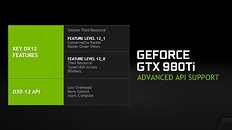Thursday, June 4th 2015

NVIDIA Could Capitalize on AMD Graphics CoreNext Not Supporting Direct3D 12_1
AMD's Graphics CoreNext (GCN) architecture does not support Direct3D feature-level 12_1 (DirectX 12.1), according to a ComputerBase.de report. The architecture only supports Direct3D up to feature-level 12_0. Feature-level 12_1 adds three features over 12_0, namely Volume-Tiled Resources, Conservative Rasterization and Rasterizer Ordered Views.
Volume Tiled-resources, is an evolution of tiled-resources (analogous to OpenGL mega-texture), in which the GPU seeks and loads only those portions of a large texture that are relevant to the scene it's rendering, rather than loading the entire texture to the memory. Think of it as a virtual memory system for textures. This greatly reduces video memory usage and bandwidth consumption. Volume tiled-resources is a way of seeking portions of a texture not only along X and Y axes, but adds third dimension. Conservative Rasterization is a means of drawing polygons with additional pixels that make it easier for two polygons to interact with each other in dynamic objects. Raster Ordered Views is a means to optimize raster loads in the order in which they appear in an object. Practical applications include improved shadows.Given that GCN doesn't feature bare-metal support for D3D feature-level 12_1, its implementation will be as limited as feature-level 11_1 was, when NVIDIA's Kepler didn't support it. This is compounded by the fact that GCN is a more popular GPU architecture than Maxwell (which supports 12_1), thanks to new-generation game consoles. It could explain why NVIDIA dedicated three-fourths of its GeForce GTX 980 Ti press-deck to talking about the features of D3D 12_1 at length. The company probably wants to make a few new effects that rely on D3D 12_1 part of GameWorks, and deflect accusations of exclusivity to the competition (AMD) not supporting certain API features, which are open to them. Granted, AMD GPUs, and modern game consoles such as the Xbox One and PlayStation 4 don't support GameWorks, but that didn't stop big game devs from implementing them.
Source:
ComputerBase.de
Volume Tiled-resources, is an evolution of tiled-resources (analogous to OpenGL mega-texture), in which the GPU seeks and loads only those portions of a large texture that are relevant to the scene it's rendering, rather than loading the entire texture to the memory. Think of it as a virtual memory system for textures. This greatly reduces video memory usage and bandwidth consumption. Volume tiled-resources is a way of seeking portions of a texture not only along X and Y axes, but adds third dimension. Conservative Rasterization is a means of drawing polygons with additional pixels that make it easier for two polygons to interact with each other in dynamic objects. Raster Ordered Views is a means to optimize raster loads in the order in which they appear in an object. Practical applications include improved shadows.Given that GCN doesn't feature bare-metal support for D3D feature-level 12_1, its implementation will be as limited as feature-level 11_1 was, when NVIDIA's Kepler didn't support it. This is compounded by the fact that GCN is a more popular GPU architecture than Maxwell (which supports 12_1), thanks to new-generation game consoles. It could explain why NVIDIA dedicated three-fourths of its GeForce GTX 980 Ti press-deck to talking about the features of D3D 12_1 at length. The company probably wants to make a few new effects that rely on D3D 12_1 part of GameWorks, and deflect accusations of exclusivity to the competition (AMD) not supporting certain API features, which are open to them. Granted, AMD GPUs, and modern game consoles such as the Xbox One and PlayStation 4 don't support GameWorks, but that didn't stop big game devs from implementing them.

79 Comments on NVIDIA Could Capitalize on AMD Graphics CoreNext Not Supporting Direct3D 12_1
Current GCN generations, 1.0, 1.1 and 1.2 are indeed limited to Feature Level 12_0, but that doesn't mean all GCN generations will be.
((there's slight change 1.0 would be limited to 11_1, but several sources suggest it can do 12_0, too))
Let's hope so then!
EDIT:
www.techpowerup.com/forums/threads/directx-12-boosts-draw-calls-by-330-on-3-year-old-gtx-670-more-details-revealed.212850/#post-3286730
What the freaking hell is this then!?
Advanced DirectX12 Graphics and Performance
Bottom line: We're all going to have to wait for Win10 and some DX12.1 software to sift through all this crap we're being fed about compatibility.
Can someone clarify without any brand bias? Obviously I can see the charts posted but has AMD stated in any press deck that they dont support tier 1?
In other use words to simplify, who the f@ck said GCN doesn't support it?
Until we get a solid source, this is just FUD.
Read more at www.legitreviews.com/geforce-gtx-980-ti-dx12-feature-level-and-tier-details_164782#TdG5DzvvlYrloE41.99
edit: Oh this is btarunr who posted this. Not buying into his Nvidia bullshit anymore.
Let both of them capitalize on solid working products.
Feature tiers and Feature Levels are completely different things
Several features have 3 different tiers, depending on hardware capabilities Card X supports Tier 1, Tier 2 or Tier 3 of feature X or Y or whatever
Feature Levels, however, are different. Feature level x may require that certain feature is supported at Tier 2 for example, but that doesn't mean that a card supporting Tier 3 on that feature would meet all the other requirements of that Feature Level.
GCN's (1.1 and 1.2 for sure, 1.0 probably) support Feature Level 12_0.
They may support some features at higher Tier than for example Maxwell does, but they still lack the required features for Feature Level 12_1, and those features they might support at higher Tier aren't required for 12_1.
And the point I was bringing up is that two of the features specifically mentioned in this article that GCN supposedly doesn't support, it does at a hardware level, unlike anything(except latest Maxwell) NV has, specifically tiled resources and conservative rasterization. Regardless of tier, these are DX12_1 features, and they are supported on-metal by GCN, which directly contradicts this "news" article.